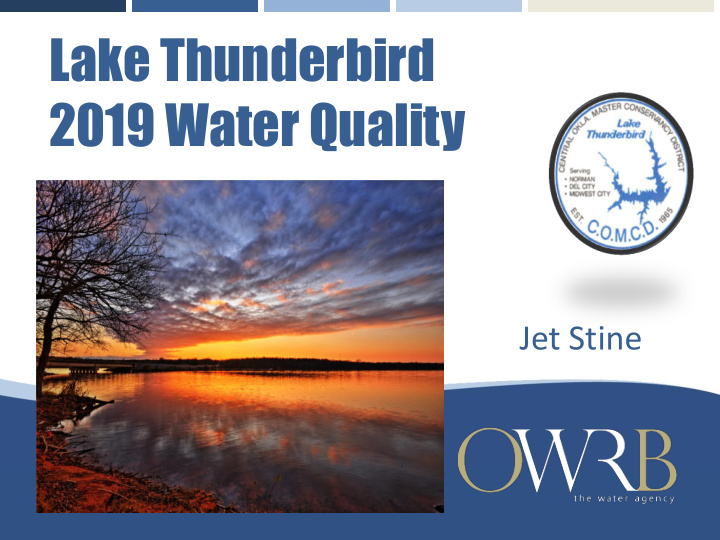



Lake Thunderbird 2019 Water Quality Jet Stine
OUTLINE Lake Ecosystem Water Quality – Physical – Chemical – Biological Drinking Water Beneficial Uses and Criteria SDOX Recommendations
› 256 square WATERSHED miles › No point source discharges › Continuing development in the watershed underscores the need for BMPs and LIDs
› Developed land LAND COVER BREAKDOWN makes up 17.7% › Largest Category Acreage Percent of Watershed Percent Change categories are Open water 8,359 5.08% +0.76% Developed, open space 12,474 7.58% -1.82% Deciduous Forest Developed, low intensity 9,182 5.58% +1.24% and Grassland/ Developed, medium intensity 6,080 3.70% +1.71% Herbaceous Developed, high intensity 1,376 0.84% +0.41% Barren Land 238 0.14% +0.13% Deciduous Forest 61,607 37.45% +2.16% › Portions of Evergreen Forest 322 0.20% -0.03% Oklahoma City, Mixed Forest 163 0.10% Moore, and Shrub Scrub 2842 1.73% Grassland/Herbaceous 55,237 33.58% -4.76% Norman in the Pasture/Hay 4,926 2.99% -0.50% watershed Cultivated Crops 1,533 0.93% -1.21% Emergent Herbaceous wetlands 20 0.01% +0.01% Total Watershed 164,505 100% 100.00%
› Eutrophication – CONCEPTUAL MODEL excessive richness of nutrients › Leads to increased algal growth and decreased DO › Nutrients are also internally released from lake sediment
› Representing all SAMPLING SCHEME zones of the lake; lacustrine, transition, and April May June July August September October riverine Frequency X X X XX XX XX X Water Quality X X X XX XX XX X Sediment X X › Water quality SDOX Dates X X X X X sampling includes nutrients, chlorophyll, and profiles › YSI profiles and nutrient samples at the SDOX nozzle site Site 12 (SDOX) at every sampling event
› YSI readings transformed into SITE 1 TEMPERATURE visual representation called an isopleth › Set-up of thermal stratification in June, mixed by late October
› YSI readings SITE 1 DISSOLVED O ₂ transformed into visual representation called an isopleth › Anoxic conditions observed May 22nd-October 9th › SDOX began operation in mid- May
› Physical Characteristics influence Chemical ones › Bottom Nutrients vs. Surface Nutrients › Stratification sequesters nutrients in the hypolimnion
› Physical Characteristics influence Chemical ones › Bottom Nutrients vs. Surface Nutrients › Stratification sequesters nutrients in the hypolimnion
› Riverine consistently higher nutrient levels than evidenced in lacustrine sites › Site 6 usually the highest, with the exception of site 11 peaks in 2017
› Riverine sites have consistently higher nutrient levels than evidenced in lacustrine sites › Pattern similar across sites
› Lacustrine and riverine sites differ in chlorophyll measurements › A majority of chlorophyll values over the 10 µg/L criteria › Values increased through the season and peaked in late summer and early Fall
› Lacustrine and riverine sites differ in chlorophyll measurements, but follow similar patterns › High turbidity likely limits even * higher algal growth
2019 TASTE AND ODOR COMPLAINTS
TASTE AND ODOR COMPLAINTS
WATER QUALITY STANDARDS Beneficial Uses Water Quality Criteria Characterize the resource Protect beneficial uses by qualities, services, & ultimate setting limits on pollutants goal for a waterbody or describing a waterbody condition Tbird Beneficial Uses Water Supply Key criteria for this project Warm Water Aquatic Chlorophyll Community Dissolved oxygen Recreation Turbidity Aesthetics Agriculture Antidegradation Policy Tbird classified as Tier 2.5, Sensitive Water Supply
WATER QUALITY EVALUATION – Chlorophyll • 75.2% above SWS criteria of 10 µg/L – Dissolved Oxygen: not to exceed 50% of volume <2 mg/L • One volumetric DO violation: » Max volumetric anoxia – 51.95% in September – Turbidity • 26.13% over WWAC criteria of 25 NTU
HISTORY of SDOX • 2009 – OWRB investigated potential in-lake BMPs • Hypolimnetic Oxygenation (HO) determined to be the best way to mitigate phosphorus release and subsequently curb algal growth • 2010 – ARRA funded a HO system as a Green Project • BlueInGreen – SDOX design, cost, implementation – Many designs were considered – Available ARRA funds limited the scope of the project • 2011 – SDOX installed • 2012 – Modifications to Nozzle and Pipe
› Directly above DISSOLVED OXYGEN the SDOX nozzle › Stratification Period › No detectable oxygen in hypolimnion
› Comparison PHOSPHORUS between the dam and nozzle site › Surface and Bottom › One of SDOX intended effects is mitigating internal phosphorus load
› Comparison NITROGEN between the dam and nozzle site › Surface and Bottom › Similar pattern to phosphorus dynamics
› Stressor and CHLOROPHYLL Response Variables › Is the SDOX having an effect on the biological dynamics? › Similar values and patterns between the two sites
SDOX CONCLUSIONS • Investigation of the SDOX in 2019 – History – Literature review – Improved monitoring and additional analysis • Evidence suggests minimal influence from SDOX • Key steps to develop the path forward • Ultimately, would not recommend discontinuing the SDOX pilot project
LAKE MONITORING CONCLUSIONS • Data collected in 2019 fails to meet water quality criteria for chlorophyll, DO, and turbidity • Low DO conditions continue to be a issue throughout the stratification period across the lake • High levels of nutrients from external and internal loading continue to drive algal growth
QUESTIONS?
Recommend
More recommend